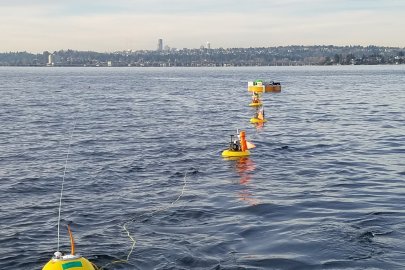From 2014 to 2020, Sandia National Labs and MRE developer Re Vision Consulting investigated advanced controls techniques in wave energy systems.
Water Power Technologies Office
January 13, 2021Through recent research, scientists have confirmed that using advanced controls can result in massive increases (up to 200%) in energy capture for wave energy devices; however, to realize maximum benefits, the controls, power-take-off (PTO) system, and basic structure of the device must all be co-designed from early stages of technology development. From 2014–2020, WPTO supported both Re Vision Consulting and Sandia in conducting controls system research focused on increasing the amount of energy captured from different types of waves to ultimately reduce the costs of power. Re Vision focused on prediction-based methodologies, which assume sensors will be deployed to monitor incoming waves, and Sandia took a broad approach to research but eventually came to favor “predictionless” techniques. Both projects arrived at similar conclusions: co-design for next-generation WECs will likely be important, and additional research and tools to support those processes are necessary.
A consistent challenge with creating energy from waves is ensuring the WEC has an optimized controls framework, which collects information from the device and feeds it back into the system so it operates as efficiently as possible. Re Vision’s favored approach used sensors to take field measurements to anticipate waves off in the distance to model and predict future wave propagation. Broadly referred to as model predictive control, the company found this approach not only enhanced WEC performance but also was the most suitable framework for handling the widest range of device-related controls challenges. Model predictive control typically relies on a forecast of wave forces over a sufficiently long prediction horizon, which Re Vision found to be strongly associated with a WEC’s specific topology and configuration.
To investigate how WEC device topology affects controls design processes, Re Vision worked with several developers with different styles of designs to capture the range of challenges encountered in optimal design. This was an especially relevant exercise, as the marine energy industry has not yet settled on a generally accepted archetype, unlike what has occurred with the wind industry and the three-bladed wind turbine. Re Vision’s process involved high-fidelity modeling, wave tank testing, hardware-in-the-loop testing, and open-ocean deployments. One of the company’s conclusions was that WEC performance improvements will be limited by how effective systems-level optimization processes are executed, with the PTO system (mechanism transforming absorbed mechanical energy into usable electricity) and its ability to modulate forces and torques cost effectively in real time being a key component of this. It is therefore important that controls design be deeply integrated into any WEC development effort, beginning with conceptual designs.
Sandia’s perspective on controls arrived at a similar conclusion, where control design should draw on and influence all aspects of WEC design, though an important distinction was their support for “predictionless” control. Throughout the course of the multiyear controls program, Sandia sought to provide developers with a guide for appropriate control strategy relative to their device and PTO system. Sandia ultimately produced a roadmap to WEC control, with a comparison broken down by metrics on control performance as well as on the requirements of implementing different strategies. Lab researchers followed an engineering approach throughout this process, in which any potential research pathway had to be justified with a cost-benefit analysis. A key takeaway from this exercise was that while Sandia found some control methods may provide more power, it found they may also require expensive design changes and/or decrease system reliability and therefore outweigh their benefit. Similarly, if one approach could provide 90% of the optimal result for 10% of the effort of other methods, the first method would be preferred. These insights led to a focus on control system approaches that do not require previous knowledge of incoming waves (i.e., “predictionless control”) through wave measurement and prediction, which can be complex and expensive. A significant benefit of these approaches is that they provide the system insights needed to execute a co-design approach.
The findings of this work inspired follow-on work led by Sandia on WEC co-design processes. Initiated in FY 2020, Sandia’s Next Generation WEC PTO Co-Design project was established to apply control design within larger device design processes (incorporating PTO systems, hulls, mooring systems, power electronics, and so on) and leveraging predictionless WEC controls as part of the framework. Using device-agnostic methodologies, the project’s goal is to allow industry developers and researchers to apply controls insights to their own devices and produce better-performing WECs. To further encourage public use of any updates and recent publicly viewable uploads, Sandia researchers regularly use presentations, workshops, and webinars to share information about the project and receive industry input.
For additional information, contact Peter Kobos and Mirko Previsic.


